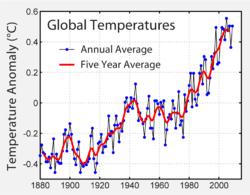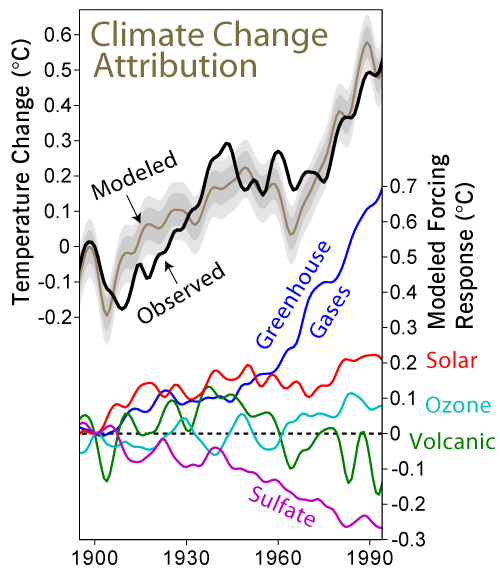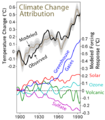이 파일은 위키미디어 공용에 있으며, 다른 프로젝트에서 사용하고 있을 가능성이 있습니다.
해당 파일에 대한 설명이 아래에 나와 있습니다.
파일 설명
| 설명Climate Change Attribution.png |
English: See extending Description below |
| 출처 | This figure was created by Robert A. Rohde from published data |
| 저자 | Robert A. Rohde |
| 다른 버전 |
[편집]
|

|
이 그림 파일은 벡터 SVG 형식으로 다시 만들어야 합니다. SVG의 장점에 대해서는 여기(영어)를 참고해 주십시오. 만약 이 그림의 SVG 버전이 이미 존재한다면 이 틀을 {{vector version available|새 파일 이름.svg}}으로 대체해 주십시오.
|
파일 설명

This figure, based on Meehl et al. (2004), shows how a global climate model (the DOE PCM [1]) is tuned to reconstruct the historical temperature record and the corresponding assumptions in the model to which the associated temperature changes can be decomposed into various forcing factors. The top part of the figure compares a five year average of global temperature measurements (Jones and Moberg 2001) to the Meehl et al. results incorporating the effects of five predetermined forcing factors: greenhouse gases, man-made sulfate emissions, solar variability, ozone changes (both stratospheric and tropospheric), and volcanic emissions (including natural sulfates). The time history and radiative forcing qualities for each of these factors was specified in advance and was not adjusted indvidually to specifically match the temperature record. The exception being the aerosol forcing which is based on expert´s judgement balancing the GHG forcing due to the inherent large uncertainty of the historical aerosol forcings.
Also shown are grey bands indicating the 68% and 95% range for natural variability in temperature relative to the climatic expectation as determined from multiple simulations with different initial conditions. In other words, they indicate the estimated size of variations that are expected to occur due to fluctuation in weather rather than changes in climate. Ideally the model should be able to reconstruct temperature variations to within about the tolerance specified by these bands. Some of the remaining misfit may be accounted for by the ~0.05 °C uncertainty in the temperature reconstruction. However, though the model captures the gross features of twentieth century climate change, it remains likely that some of the differences between model and observation still reflect the limitations of the model and/or our understanding of the histories of the observed forcing factors.
In the lower portion of the figure are the results of additional simulations in which the model was operated with only one forcing factor used at a time. A key conclusion of the Meehl et al. (2004) work is that the model response to all factors combined is to a good approximation equal to the sum of the responses to each factor taken individually. This means it is reasonable to talk about the temperature change due to individual aspects of the evolving man-made and natural influences on climate. The zeros on both plots are set equal to 1900 temperatures, and it is apparent that most of the 0.52 °C global warming between 1900 and 1994 should be attributed to a 0.69 °C temperature forcing from greenhouse gases partially offset by a 0.27 °C cooling due to man-made sulfate emissions and with other factors contributing the balance. This contrasts with the warming from 1900 to 1940 for which the model only attributes a net increases of 0.06 °C to the combined effects of greenhouse gases and sulfate emissions.
| Temperature change relative to 1900 | |||
|---|---|---|---|
| 1940 | 1970 | 1994 | |
| Greenhouse gases | 0.10 | 0.38 | 0.69 |
| Sulfate emissions | -0.04 | -0.19 | -0.27 |
| Solar forcing | 0.18 | 0.10 | 0.21 |
| Volcanic forcing | 0.11 | -0.04 | -0.14 |
| Ozone | -0.06 | 0.05 | 0.08 |
| Net | 0.19 | 0.17 | 0.53 |
| Observed | 0.26 | 0.21 | 0.52 |
Note that "Net" reflects the model runs with all factors included and is not identical to simply summing the individual factors.
References
- Meehl, Gerald A.; Washington, Warren M.; Ammann, Caspar M.; Arblaster, Julie M.; Wigley, T. M. L.; Tebaldi, Claudia (2004). "Combinations of Natural and Anthropogenic Forcings in Twentieth-Century Climate". Journal of Climate 17: 3721–7. DOI:10.1175/1520-0442(2004)017%3C3721:CONAAF%3E2.0.CO;2. ISSN 1520-0442.
- Jones, P. D.; Moberg, A. (2003). "Hemispheric and Large-Scale Surface Air Temperature Variations: an Extensive Revision and an Update to 2001". Journal of Climate 16: 206–23. DOI:10.1175/1520-0442(2003)016%3C0206:HALSSA%3E2.0.CO;2. ISSN 1520-0442.
라이선스
This figure was created by Robert A. Rohde from published data and is incorporated into the Global Warming Art project.

|
GNU 자유 문서 사용 허가서 1.2판 또는 자유 소프트웨어 재단에서 발행한 이후 판의 규정에 따라 본 문서를 복제하거나 개작 및 배포할 수 있습니다. 본 문서에는 변경 불가 부분이 없으며, 앞 표지 구절과 뒷 표지 구절도 없습니다. 본 사용 허가서의 전체 내용은 GNU 자유 문서 사용 허가서 부분에 포함되어 있습니다.http://www.gnu.org/copyleft/fdl.htmlGFDLGNU Free Documentation Licensetruetrue |
| 이 파일은 크리에이티브 커먼즈 저작자표시-동일조건변경허락 3.0 Unported 라이선스로 배포됩니다. | ||
| ||
| 이 라이선스 틀은 GFDL 라이선스 변경의 일부로 이 파일에 추가되었습니다.http://creativecommons.org/licenses/by-sa/3.0/CC BY-SA 3.0Creative Commons Attribution-Share Alike 3.0truetrue |

|
이 그림 파일은 벡터 SVG 형식으로 다시 만들어야 합니다. SVG의 장점에 대해서는 여기(영어)를 참고해 주십시오. 만약 이 그림의 SVG 버전이 이미 존재한다면 이 틀을 {{vector version available|새 파일 이름.svg}}으로 대체해 주십시오.
|
설명
이 파일에 묘사된 항목
다음을 묘사함
image/png
29,177 바이트
573 화소
500 화소
파일 역사
날짜/시간 링크를 클릭하면 해당 시간의 파일을 볼 수 있습니다.
| 날짜/시간 | 크기 | 사용자 | 댓글 | |
|---|---|---|---|---|
| 현재 | 2014년 7월 17일 (목) 02:08 | 500 × 573 (28 KB) | JeffyP | Shrinkin' the image. |
이 파일을 사용하는 문서
이 파일을 사용하는 문서가 없습니다.




